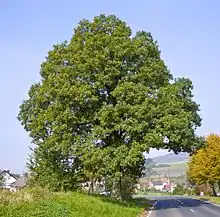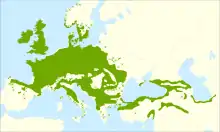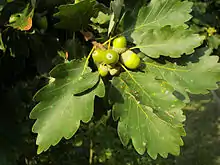Quercus petraea
Quercus petraea, commonly known as the sessile oak,[3] Cornish oak,[4] Irish Oak or durmast oak,[5] is a species of oak tree native to most of Europe and into Anatolia and Iran. The sessile oak is the national tree of the Republic of Ireland,[6] and an unofficial emblem in Wales[7] and Cornwall.[8][9]
| Quercus petraea | |
|---|---|
 | |
| A mature tree | |
| Scientific classification | |
| Kingdom: | Plantae |
| Clade: | Tracheophytes |
| Clade: | Angiosperms |
| Clade: | Eudicots |
| Clade: | Rosids |
| Order: | Fagales |
| Family: | Fagaceae |
| Genus: | Quercus |
| Subgenus: | Quercus subg. Quercus |
| Section: | Quercus sect. Quercus |
| Species: | Q. petraea |
| Binomial name | |
| Quercus petraea | |
 | |
| Distribution map | |
| Synonyms[2] | |
|
List
| |


Description
The sessile oak is a large deciduous tree up to 20–40 m (66–131 ft) tall, in the white oak section of the genus (Quercus sect. Quercus) and similar to the pedunculate oak, Q. robur, with which it overlaps extensively in range. The leaves are 7–14 cm (2.8–5.5 in) long and 4–8 cm (1.6–3.1 in) broad, evenly lobed with five to six lobes on each side and a 1-centimetre-long (0.39 in) petiole. The male flowers are called catkins, produced in the spring. The fruit is an acorn 2–3 cm (0.79–1.18 in) long and 1–2 cm (0.39–0.79 in) broad, which matures in about six months.
Comparison with pedunculate oak
Significant botanical differences from pedunculate oak (Quercus robur) include the stalked leaves, and the stalkless (sessile) acorns from which one of its common names is derived. It occurs in upland areas over 300 m (984 ft) with higher rainfall and shallow, acidic, sandy soils. Its specific epithet petraea means "of rocky places".[10] Quercus robur, on the other hand, prefers deeper, richer soils at lower altitude. Fertile hybrids with Quercus robur named Quercus × rosacea are found wherever the two parent species occur and share or are intermediate in characters between the parents.
Charles Darwin, in Chapter II of On the Origin of Species, noted that the sessile and pedunculate oaks had been described as both distinct species and mere varieties depending on the authority consulted.
Uses
Sessile oak is one of the most important species in Europe both economically and ecologically. Oak timber is traditionally used for building, ships and furniture. Today the best woods are used for quality cabinetmaking, veneers and barrel staves.[11] Rougher material is used for fence construction, roof beams and specialist building work. The wood also has antimicrobial properties.[12][13] It is also a good fuel wood. During autumns with good acorn crops (the mast years), animals are traditionally grazed under the trees to fatten them.[14]
Pontfadog Oak
The Pontfadog Oak, once considered to be the oldest oak tree in the UK, was a sessile oak. This grew near Chirk in North Wales. It was understood to be over 1,200 years old, an age that was due to regular pollarding for much of its life. The hollow trunk had a girth of 12.9 metres (42 ft 5 in). It was lost in April 2013 when it blew down in high winds.[15]
Diseases and pests
- Acute oak decline
- Sudden oak death
- The Welsh oak longhorn beetle (Pyrrhidium sanguineum) is named for its host tree; the larvae feed at the bark interface of dead wood.[16]
See also
References
- Gorener, V.; Khela, S.; Barstow, M. (2017). "Quercus petraea". IUCN Red List of Threatened Species. 2017: e.T62539A3116237. doi:10.2305/IUCN.UK.2017-3.RLTS.T62539A3116237.en.
- "Quercus petraea". World Checklist of Selected Plant Families (WCSP). Royal Botanic Gardens, Kew. Retrieved 14 Sep 2016 – via The Plant List.
- "BSBI List 2007". Botanical Society of Britain and Ireland. Archived from the original (xls) on 2014-10-23. Retrieved 14 Sep 2016.
- "Sessile oak". ARKive.org. Archived from the original on 2017-05-30. Retrieved 2017-05-15.
- "Quercus petraea". Germplasm Resources Information Network (GRIN). Agricultural Research Service (ARS), United States Department of Agriculture (USDA). Retrieved 14 Sep 2016.
- Mitchell, Alan (1974). "Field Guide to the Trees of Britain and Northern Europe (Collins Field Guide)", HarperCollins Distribution Services, New York. ISBN 0002120356.
- "Tree trail with worldwide flavour", BBC News, 23 July 2004
- Minahan, James (2009). The complete guide to national symbols and emblems. 1. Greenwood. ISBN 978-0313344961.
- West Briton, September 01, 2011, Will native trees thrive in the future? Archived June 9, 2013, at the Wayback Machine
- Harrison, Lorraine (2012). RHS Latin for gardeners. United Kingdom: Mitchell Beazley. p. 224. ISBN 9781845337315.
- Munir, Muhammad Tanveer; Pailhories, Hélène; Eveillard, Matthieu; Irle, Mark; Aviat, Florence; Federighi, Michel; Belloncle, Christophe (24 August 2020). "Experimental Parameters Influence the Observed Antimicrobial Response of Oak Wood (Quercus petraea)". Antibiotics. 9 (9): 535. doi:10.3390/antibiotics9090535.
- Munir, Muhammad; Aviat, Florence; Lepelletier, Didier; Pape, Patrice Le; Dubreil, Laurence; Irle, Mark; Federighi, Michel; Belloncle, Christophe; Eveillard, Matthieu; Pailhoriès, Hélène (1 October 2020). "Wood materials for limiting the bacterial reservoir on surfaces in hospitals: would it be worthwhile to go further?". Future Microbiology. 15 (15): 1431–1437. doi:10.2217/fmb-2019-0339.
- Chen, Ju-Chi; Munir, Muhammad Tanveer; Aviat, Florence; Lepelletier, Didier; Le Pape, Patrice; Dubreil, Laurence; Irle, Mark; Federighi, Michel; Belloncle, Christophe; Eveillard, Matthieu; Pailhoriès, Hélène (13 November 2020). "Survival of Bacterial Strains on Wood (Quercus petraea) Compared to Polycarbonate, Aluminum and Stainless Steel". Antibiotics. 9 (11): 804. doi:10.3390/antibiotics9110804.
- Ducousso, A. & Bordacs, S. (2004), Pedunculate and sessile oaks – Quercus robur/Quercus petraea: Technical guidelines for genetic conservation and use (PDF), European Forest Genetic Resources Programme, p. 6
- "Pontfadog Oak: 1,200-year-old tree toppled by winds". BBC News Online. 18 April 2013.
- Bullock, J.A. 1992. Host Plants of British Beetles: A List of Recorded Associations – Amateur Entomologists' Society (AES) publication volume 11a: A supplement to A Coleopterist's Handbook.
External links
- Quercus petraea Royal Horticultural Society
- Quercus petraea – distribution map, genetic conservation units and related resources. European Forest Genetic Resources Programme (EUFORGEN)
- Flora Europaea: Quercus petraea
- Bean, W. J. (1976). Trees and shrubs hardy in the British Isles 8th ed., revised. John Murray.
- Rushforth, K. (1999). Trees of Britain and Europe. HarperCollins ISBN 0-00-220013-9.
- (in French) Chênes: Quercus petraea
- Den virtuella floran – Distribution
 Media related to Quercus petraea at Wikimedia Commons
Media related to Quercus petraea at Wikimedia Commons Data related to Quercus petraea at Wikispecies
Data related to Quercus petraea at Wikispecies
